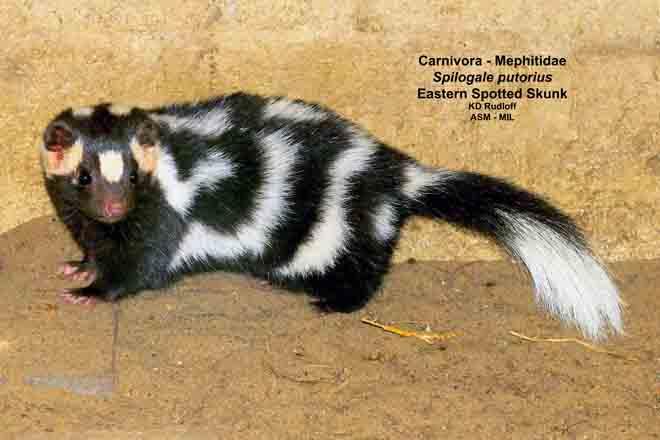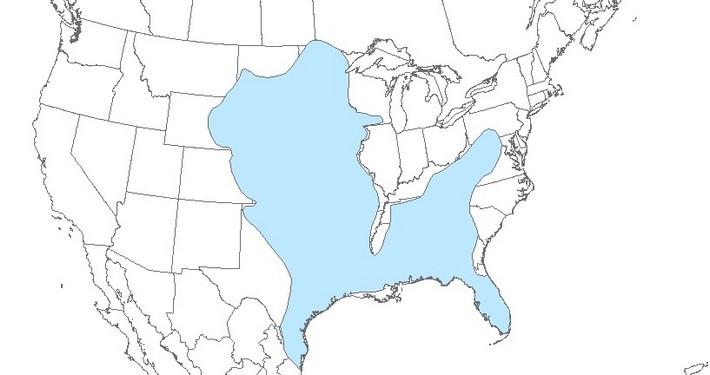
Description
Spotted skunks are largely nocturnal, medium-sized omnivores in the weasel family (Mustelidae). Skunks are about the size of house cats, and have distinctive black and white fur patterns. Skunks detected in the Great Lakes region are usually striped skunks, as only 6 spotted skunks have been detected in Minnesota in the last 20 years despite intensive efforts (Minnesota DNR, 2017). Spotted skunks have a more complicated pattern of spots and broken lines, while striped skunks have two white stripes running from head to tail.
Size
Measurements from Minnesota are from Hazard (1982), from Wisconsin are from Jackson (1961), and from the Eastern United States are from Hamilton and Whitaker (1998). Total length ranged from 17.5” to 21.7” (445-550 mm) in Wisconsin, and from 15.9” to 24.0” (403-610 mm) in the Eastern United States.Male total length ranged from 18.5” to 21.7” (470-550 mm) in Minnesota, and female total length ranged from 17.5” to 19.0” (445-482 mm) in Minnesota.Tail length ranged from 6.6” to 13.0” (168-330 mm) in Wisconsin, and from 6.5” to 11.0” (165-280 mm) in the Eastern United States.Male tail length length ranged from 7.0” to 8.7” (178-220 mm) in Minnesota, and female tail length ranged from 6.5” to 7.9” (165-200 mm) in Minnesota.Male body weight ranged from 0.9 to 4.0 lb (0.4-1.3 kg) in Minnesota, and female body weight ranged from 0.7 to 1.3 lb (0.3-0.6 kg) in Minnesota.
Males are typically larger than females.
Distribution & Status
Spotted skunks were a common component of the Great Plains, Appalachians, and Southeastern U.S. regions, until the 1940s when populations crashed (except for the Florida subspecies). Since the 1940s, populations have continued to decline precipitously, except for the stable Florida population (Gompper and Hackett, 2005).
Modernization of agricultural practices (removing hedgerows, clearing edges, use of pesticides), as well as trapping may have contributed to the declines, but no definitive cause(s) has been determined (Gompper and Hackett, 2005; IUCN, 2017). Populations are critically imperiled and imperiled in Minnesota, North Dakota, and Iowa, and vulnerable in South Dakota.
Worldwide, Spilogale putoris is restricted to North America. The western spotted skunk, Spilogale gracilis, occurs throughout the western U.S., where populations are thriving. Two additional Spilogale species occur in Mexico.
Spotted skunks have an IUCN rank of Vulnerable, IUCN information.
Incidence in Minnesota
Regional records suggest that in the early 1900s, spotted skunks extended their range northward into Minnesota (Minnesota DNR, 2017). Spotted skunks were common around farms, and state harvest peaked at 19,400 in 1946, before populations plummeted. Since 1996, spotted skunks have been classified as threatened in Minnesota, and any sightings should be reported to Minnesota DNR. Hunting and trapping are regulated by the Minnesota Department of Natural Resources, regulations here.
Population Trends
To help assess population trends, we can look at regional furbearer harvest data, methods here.
In the Upper Midwest, only South Dakota has reported spotted skunk harvest in the last 30 years. From 2009-2014 a modest skunk harvest was reported, with much year-to-year variation.
Life History
Spotted skunks live in fields and nearby cover, such as fencerows, gullies, barns, outbuildings, thickets, woodpiles, hollow logs, and riparian woodlands. In the Great Plains, spotted skunks are closely associated with farmlands (Chapman and Feldhamer, 1982). Spotted skunks eat a variety of arthropods, small mammals, birds, eggs, lizards, snakes, frogs, carrion, garbage, fruits, and corn, but especially insects, rabbits and rodents (Hazard, 1982). Mating occurs in April, and after a 50-65 day gestation, 4-6 kits are born in June in dens under cover. Kits are blind until their eyes open at about one month, can emit musk at 1.5 months, are about as large as adults at 3 months, are able to disperse by 4 months, and are sexually mature by 1 year. Spotted skunks can climb trees, and spray is their primary defense. Spotted skunks will sometimes perform a handstand on front legs as a warning before spraying. Skunks are prey for raptors and larger mammal carnivores.
Contacts with Humans
Farmers initially provided additional habitat for spotted skunks by draining marshes and providing additional cover, but modernization of farms has eliminated cover habitat. Skunks spray when threatened, serving as a nuisance for sprayed humans and pets. In addition, skunks will occasionally raid hen houses, and spotted skunks are a carrier of rabies. Thus, detected skunks are sometimes trapped or poisoned as a pest species. Skunks are a significant asset in controlling the populations of crop-destroying rodents and insects.

